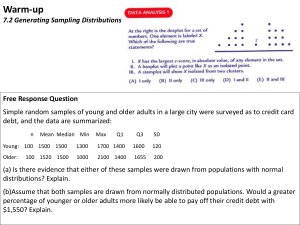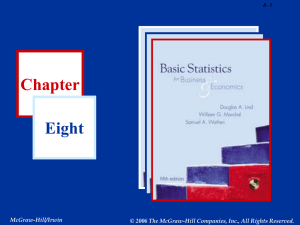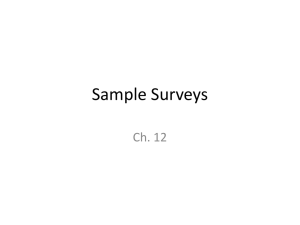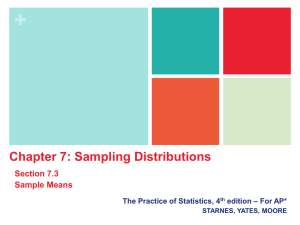Sec. 9.3 PowerPoint
advertisement
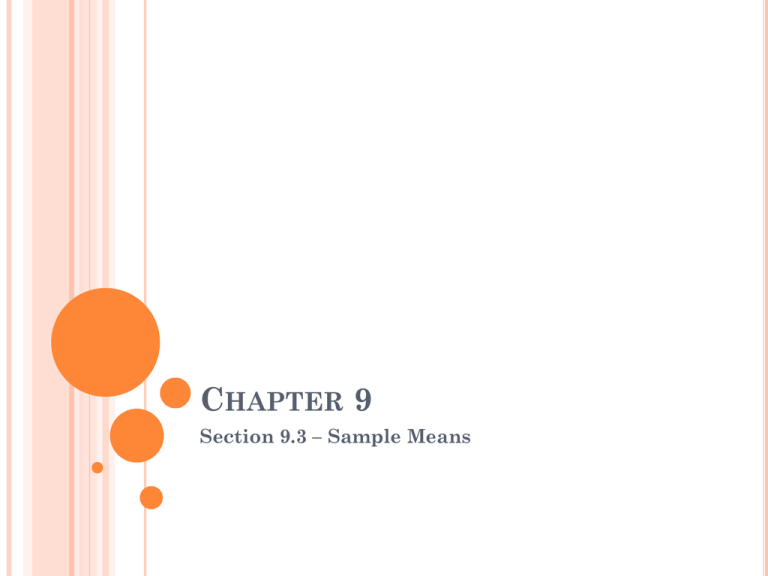
CHAPTER 9 Section 9.3 – Sample Means SAMPLE MEANS Sample proportions arise most often when we are interested in categorical variables. When we record quantitative variables we are interested in other statistics such as the median or mean or standard deviation of the variable. Sample means are among the most common statistics. Consider the mean household earnings for samples of size 100. Compare the population distribution on the left with the sampling distribution on the right. What do you notice about the shape, center, and spread of each? THE SAMPLING DISTRIBUTION OF When we choose many SRSs from a population, the sampling distribution of the sample mean is centered at the population mean µ and is less spread out than the population distribution. Here are the facts. Mean and Standard Deviation of the Sampling Distribution of Sample Means Suppose that x is the mean of an SRS with mean and standard deviation of size n drawn from a large population . Then : The mean of the sampling distribution of The standard deviation x is x of the sampling distribution of x x is n as long as the 10% condition is satisfied: n ≤ (1/10)N. Note : These facts about the mean and standard deviation of no matter what shape the population distribution x are true has . SAMPLING FROM A NORMAL POPULATION We have described the mean and standard deviation of the sampling distribution of the sample mean 𝑥, but not its shape. This is because the shape of the distribution of 𝑥 depends on the shape of the population distribution. In one important case, there is a simple relationship between the two distributions. If the population distribution is normal, then so is the sampling distribution of 𝑥. This is true no matter what the sample size is. Sampling Distribution of a Sample Mean from a Normal Population Suppose that a population is Normally distribute d with mean and standard deviation . Then the sampling distributi on of x has the Normal distributi on with mean and standard deviation / n , provided that the 10% condition is met. Example 9.10 & 9.11 – Young Women’s Heights The height of young women follows a Normal distribution with mean µ = 64.5 inches and standard deviation σ = 2.5 inches. Find the probability that a randomly selected young woman is taller than 66.5 inches. Let X = the height of a randomly selected young woman. X is N(64.5, 2.5) z 66 .5 64 .5 2.5 0.80 P ( X 66 .5) P (Z 0.80 ) 1 0.7881 0.2119 The probability of choosing a young woman at random whose height exceeds 66.5 inches isabout 0.21. Find the probability that the mean height of an SRS of 10 young women exceeds 66.5 inches. Since the population distribution is Normal, For an SRS of 10 young women, the the sampling distribution will follow an N(64.5, sampling distribution of their sample 0.79) distribution. mean height will have a mean and P ( x 66 .5) P (Z 2.53 ) 66 .5 64 .5 standard deviation z 2.53 x 64 .5 x n 2.5 10 0.79 0.79 1 0.9943 0.0057 It is very unlikely (less than a 1% chance) that we would choose an SRS of 10 young women whose average height exceeds 66.5 inches. THE CENTRAL LIMIT THEOREM Most population distributions are not Normal. What is the shape of the sampling distribution of sample means when the population distribution isn’t Normal? It is a remarkable fact that as the sample size increases, the distribution of sample means changes its shape: it looks less like that of the population and more like a Normal distribution! When the sample is large enough, the distribution of sample means is very close to Normal, no matter what shape the population distribution has, as long as the population has a finite standard deviation. Definition: Draw an SRS of size n from any population standard deviation is large, the sampling with mean μ and finite σ. The central limit theo rem (CLT) says that when distributi on of the sample mean n x is approximat ely Normal. Note: How large a sample size n is needed for the sampling distribution to be close to Normal depends on the shape of the population distribution. More observations are required if the population distribution is far from Normal. THE CENTRAL LIMIT THEOREM Consider the strange population distribution from the Rice University sampling distribution applet. Normal Condition for Sample Means If the population distribution is Normal, then so is the sampling distribution of x . This is true no matter what the sample size n is. If the population distribution is not Normal, the central limit theorem tells us that the sampling distribution of x will be approximately Normal in most cases if n 30 . EXAMPLE 9.13 - SERVICING AIR CONDITIONERS Based on service records from the past year, the time (in hours) that a technician requires to complete preventative maintenance on an air conditioner follows the distribution that is strongly right-skewed, and whose most likely outcomes are close to 0. The mean time is µ = 1 hour and the standard deviation is σ = 1 Your company will service an SRS of 70 air conditioners. You have budgeted 1.1 hours per unit. Will this be enough? Since the 10% condition is met (there are more than 10(70)=700 air conditioners in the population), the sampling distribution of the mean time spent working on the 70 units has 1 x 1 x n 70 0.12 The sampling distribution of the mean time spent working is approximately N(1, 0.12) since n = 70 ≥ 30. We need to find P(mean time > 1.1 hours) z 1.1 1 0.12 0.83 P ( x 1.1) P (Z 0.83 ) 1 0.7967 0.2033 If you budget 1.1 hours per unit, there is a 20% chance thetechnicians will not complete the work within the budgeted time. Homework: p.519-529 #’s 32, 33, 39-41, & 47-49


